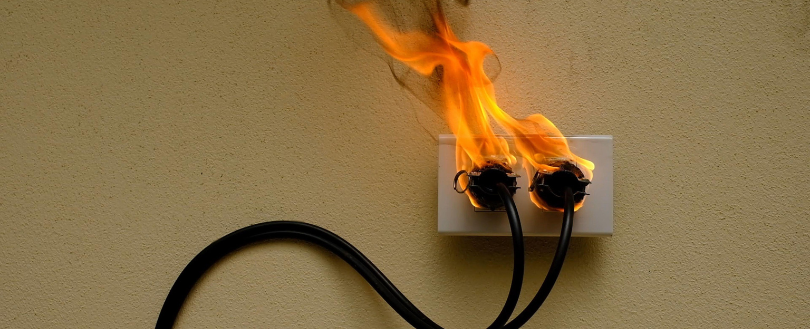
Pull the Plug on Fire Risks: Stopping Socket Overload Before It Starts
Like it? Share it!
16 October 2025
Overloading electrical sockets is a common but serious fire risk that is often overlooked. Many people are tempted to add "just one more" plug into a multi-adaptor, even when several appliances are already connected. However, doing so can place excessive strain on the socket and wiring, leading to overheating and, in some cases, electrical fires.
Thousands of electrical fires each year are preventable, with overloading among the most frequent causes.
What Does Overloading Electrical Sockets Mean?
Overloading occurs when the total electrical current drawn by appliances exceeds what a socket is designed to handle. When this happens, the wiring can become excessively hot, increasing the risk of damage or fire.
A typical example would be plugging several high-wattage items such as heaters, kettles or hair dryers into a single socket or extension lead at the same time. Even though some extension strips have four or six outlets, they still draw power from one wall socket, so the total load must not exceed the rated limit.
Excessive heat from overloading can melt insulation, damage components and, in some cases, ignite nearby materials.
Dangers of Overloading Sockets
Fire Risk
Overloaded sockets can cause the internal components and wiring to overheat, potentially leading to electrical fires. These fires may start behind walls or within sockets, making them difficult to detect until it is too late. Once alight, electrical fires can spread quickly and release toxic smoke.
Damaged Wiring
Persistent overloading gradually degrades the integrity of the wiring and socket components. Over time, insulation can melt or become charred, leaving the system unsafe for future use.
Electric Shock
Overheating and melted components can expose live parts, creating a serious risk of electric shock to anyone using or touching the socket.
Blown Fuses and Tripped Circuit Breakers
Repeated overloading can cause fuses to blow or circuit breakers to trip frequently. While these are designed to protect you, constant tripping can weaken a circuit breaker, reducing its reliability and potentially allowing an overload to go unnoticed.
How to Avoid Overloading
• One plug per socket: Avoid plugging multiple high-wattage appliances into a single socket.
• Do not "daisy chain" adaptors: Connecting extension leads together significantly increases the load and the risk of overheating.
• Use quality adaptors: Always choose extension leads with built-in fuses or surge protection. Avoid cube-style block adaptors, which can easily overheat.
• Check ratings: Ensure the combined wattage of devices plugged into an extension lead does not exceed its stated maximum limit.
• Install more outlets: For high-powered appliances, have additional sockets fitted by a qualified electrician to spread the load safely.
• Fully unwind extension cables: Coiled cables can build up heat even under normal loads, so always unwind them completely before use.
Warning Signs of Overload
Be alert to early indicators of overheating or damage:
• Plugs or sockets feel hot to the touch
• Burning smells or melting plastic
• Scorch marks around the outlet
• Buzzing or crackling sounds
• Fuses blowing repeatedly
Recognising these signs early can prevent serious incidents.
Overloading sockets is an avoidable hazard that requires only a little awareness and care. By understanding the limits of electrical circuits and following safe practices, you can significantly reduce the risk of fire or electrical damage in your home or workplace.
View the source.
Our eNews provides regular insight into industry trends, news headlines, and product and service information. For more articles like this Subscribe to our enews.
Related news
-
RSH Publishes Fire Safety Remediation Report for Q1 2025-2026
29 September 2025
Related resources
-
Passenger Service Vehicle - Guidance Note
05 September 2023
